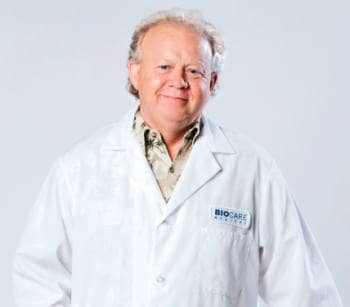
Biocare Medical’s innovations are grounded in patient care, says David Tacha, HTL (ASCP), PhD, vice president of R&D, chief scientific officer, and one of the company’s founders.
When you walk into the lab of David Tacha, HTL (ASCP), PhD, vice president of R&D, chief scientific officer, Biocare Medical, Concord, Calif, you see photographs of famous people: John Wayne, Shirley Temple, and Lance Armstrong—people who were cancer survivors or who have died of cancer. Each picture serves as a reminder that everything done at Biocare Medical is for the patients. It is instilled into every employee that the awareness of the fact that behind every slide is a human being. This is the powerful driving force within the company.
Tacha co-founded Biocare Medical in 1997 with Roy Paxton Yih and Gene Castagnini, all present owners of the company. Their objective was to form a new company with strong foundations in tech support and education. Biocare has become known as an innovator in immunohistochemistry (IHC) technology.
“We believed that there was a lack of not just troubleshooting technical problems, but of giving out information of a purely educational basis,” Tacha says. “The Biocare Education Center was developed for people to receive continuing education. We wanted to develop equipment and reagents through strong R&D innovation.”
One of the things the company is proud of is the invention developed around Multiplex IHC products or double stains. For a double stain, they were able to put two, three, or four antibodies onto a single tissue section and see morphology and color, looking at one slide instead of three to four slides. Multiple slides create the problem of sequential viewing and limited tissue.
In 2003 and 2004 there had yet to be a ready-to-use double stain kit that was suitable for clinical applications, something reproducible, labeled IVD for reimbursement, and that could be used on an automated staining system. “We were the first company in the United States that actually developed a double-stain primary antibody with a double-stain detection kit that could be used for routine diagnostic procedures,” Tacha says. “But we took this one step further …

“We not only took the double stain so that you could see two different antibodies or two different types of diagnosis, but we now started color coding cancer cells,” Tacha adds. “So what we did—and this is the key that makes it totally unique to any double stain that has ever been done—is that we would label compartments of tumor cells, or tumor structures with colors. We made a ‘spectral fingerprint.’ ” Pathologists could now see the difference between something that was benign or something that potentially was malignant cancer: a spectral fingerprint based on colors and morphology.
The only double stains that had ever been done before were in research labs—using a sequential detection, and taking a long time to process. Biocare’s system can process up to five antibodies on a single slide in less than 3 hours. Not only does this save money, time, and limited tissue, but even more important is now the spectral fingerprint is part of the diagnostic procedure.
Every Multiplex IHC is unique. These “fingerprints”give pathologists the assurance that their diagnosis is accurate, and helps oncologists properly treat their patients—especially those with a difficult diagnosis such as breast, bladder, or prostate cancer. Multiplex IHC is now being used on a routine basis as a spectral fingerprint that is used everywhere from community hospitals to university hospitals.
Biocare’s Multiplex IHC tests—PIN-4, ADH-5, Uro-3, and the most recent innovation called the PulmoPanel, used for differentiation of squamous versus adenocarcinoma in non-small cell lung cancer diagnosis—are used primarily in hospitals and university hospitals. However, this is no longer purely research; they are routinely used as a clinical application. “The beauty of our diagnostic kits is that they can be used on other people’s platforms,” Tacha says.
What separates Biocare from other companies is the very strong need to continue to push the envelope of innovation, Tacha says. He once asked a famous pathologist, “What keeps you up at night? ‘This is my dilemma,’ [he told me]: ‘I’m doing the best I can, but I know that I don’t have the proper tools to give accuracy 100% of the time. As a pathologist who cares about his patients, that keeps me up at night.’ It keeps me up at night, too.
“Everyone has a stainer and antibodies,” Tacha continues. “What can this company do that will have a stronger impact on patient care? What will give more diagnostic power? Now I can go home and say thousands of patients got an accurate diagnosis because of the work that we’ve done at Biocare.”
This is a true success story of a small entrepreneurial company. Biocare Medical has become a market leader in simultaneous Multiplex IHC. It is quickly and freely moving innovation forward. “We have competed with the giants, and we have created new technology that they can only copy,” Tacha says.
“It’s kind of interesting. When I was at BioGenex, I used to be Roy Yih’s boss, and now he’s my boss,” Tacha continues. “But Roy feels the same way. Patient care burns in his soul: It’s instilled in him that when we sell an antibody, it’s not just going on a slide. There’s a patient behind the slide. When we say ‘One slide at a time,’ it’s like one patient at a time. And this has driven these innovations.”
JL Silverman is a contributing writer for CLP.



